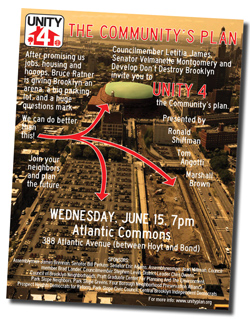Construction on the Barclays Center arena is well under way at Atlantic Yards, but the rest of the 22-acre project remains in doubt thanks in large part to our slow economy. With uncertainty surrounding the megaproject, is there finally room for the community to create a new model for responsible development?
 The hope for a better plan drew a standing-room-only crowd to the first meeting of Unity 4, an effort to re-engage the community in the project and shape a compelling framework for the site’s future. The Civic Council was among the several community groups and elected officials sponsoring the event, held June 15 at The Commons on Atlantic Avenue.
The hope for a better plan drew a standing-room-only crowd to the first meeting of Unity 4, an effort to re-engage the community in the project and shape a compelling framework for the site’s future. The Civic Council was among the several community groups and elected officials sponsoring the event, held June 15 at The Commons on Atlantic Avenue.
The meeting was the first step in a six- to nine-month planning process that will demand community participation. Organizers expect Unity 4 to be a revision of the first Unity plan, created by community leaders in 2007 in response to the initial Atlantic Yards plans.
“The original plan from [developer] Forest City Ratner was a pipe dream,” said City Councilmember Letitia James, one of the meeting’s organizers. Instead, “Can we reclaim public assets for the community? We need to recommit ourselves to the struggle … for community development and responsible development.”
The only plans moving forward right now are for the basketball arena and a massive 1,100-spot parking lot. “We need to look at the reality of the [Forest City Ratner] plan, which will take much longer than planned, and re-envision the space,” said Ron Shiffman, former city planning commissioner and longtime head of the Pratt Center for Community Development.
“The politics involved will be changing over the next couple of years,” he added, with a new mayor and borough president who might support a different plan, unlike the officials now in those positions. “We need to commit to the fight for affordable housing, and develop an open and equitable model for planning.”
According to Daniel Goldstein of Develop Don’t Destroy Brooklyn, the land beyond the arena and parking lot — Phase 2, east of Sixth Avenue — is “not fully under Forest City’s control.” He noted that “there’s the possibility for leverage when politicians change to get some of that land back.”
All of this means a new plan by and for the community may have room to flourish. “It’s not just about the arena,” said presenter Marshall Brown, professor of architecture and urban design at the Illinois Institute of Technology and a former Fort Greene resident, “but about the future of our communities.”
Gib Veconi, of BrooklynSpeaks, discussed the need for monitoring and governance of the site in order to help get better results for the community. He told the audience that the legal fight over approval of the developer’s general project plan is still ongoing. With no other oversight over construction, there is a pressing need for transparency in both development and construction. Atlantic Yards Watch, a website set up by the Civic Council and other community groups, can act as a “community watchdog” over the project, Veconi said.
“We need a vision of development that is different and that resonates with more people,” said Councilmember Brad Lander. “We need to get the head of the ESDC and the governor to engage on this.”
“This is a moment of opportunity,” added Councilmember Steven Levin. “The world of 2003 [when Forest City Ratner unveiled its Atlantic Yards plan] doesn’t exist anymore — there’s no more velocity of capital.” Candidates in 2013 “should get on the record about development moving forward.”
Organizers for Unity 4 hope to take advantage of the economic and political changes around Atlantic Yards to shape a more responsive model. Plans are taking shape for the next Unity 4 meeting in the fall. Visit the Civic Council’s website or the Atlantic Yards Report for updates.
— Reported by Sarah Murphy, written by David Herman
from the Summer 2011 Civic News

